The Ultimate Guide To Interval Training
From the track to CrossFit, interval training is gaining steam everywhere — and for good
reason. Alternating bursts of intense activity with periods of no- or low-intensity activity
(known as active recovery), interval training effectively bumps up the heart rate, burns
more calories and fat, and is more efficient compared to steady-state cardio (like jogging
at the same pace for an extended period of time). No matter your fitness level, or
preferred way to exercise, just about anyone can try out interval training.
What is High Intensity Interval Training?
High intensity interval training (HIIT) involves exercising at a high intensity (for 30
seconds to several minutes) then recovering with low intensity exercise for 1-5 minutes
http://www.ncbi.nlm.nih.gov/pubmed/23210120. While athletes have trained with intervals for
decades, recent research points to short
bursts of all-out intensity (coupled with short periods of rest) as an effective way to
improve cardiovascular function and physical performance in less time than exercising
with the same intensity for a full workout http://www.ncbi.nlm.nih.gov/pmc/articles/PMC2988497/.
Bottom line: high intensity means getting
the job done in a jiffy.
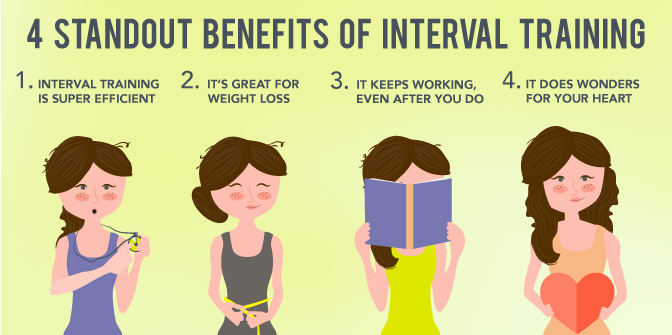
4 Standout Benefits of Interval Training
1. Interval training is hyper efficient.
While hitting the gym for an hour session may be the norm for many, it’s simply not
practical for some of us. The good news is that research shows high intensity interval
training has similar effects on the body to that of endurance training, but with less of a
time commitment
http://www.unboundmedicine.com/medline/citation/22194005/http://jp.physoc.org/content/588/6/1011.long.
In one study, 8-12 one-minute intervals of high intensity had
the same effect on metabolism and muscle function as about 90 minutes of cycling at a
moderate pace http://www.ncbi.nlm.nih.gov/pubmed/23210120. Even if we think we don’t have time
to workout, a quick 10-20 minute interval workout can still be beneficial.
2. It’s great for weight loss.
Moving in general is an integral part of shedding pounds, but including higher intensity
intervals has been shown to amplify weight loss http://www.ncbi.nlm.nih.gov/pmc/articles/PMC3135883/.
Studies show high intensity intervals reduced more abdominal fat compared to sessions
of moderate intensity
http://www.ncbi.nlm.nih.gov/pubmed/22854902 http://www.ncbi.nlm.nih.gov/pmc/articles/PMC2991639/ http://www.ncbi.nlm.nih.gov/pubmed/19151592.
The formula is simple — the harder you work out, the more calories you’ll burn
http://www.ncbi.nlm.nih.gov/pubmed/21311363.
3. It keeps working, even after you do.
After a sweat sesh, our metabolism can stay elevated for a period of time — a term
known as the afterburn effect (i.e. we burn more calories after exercise is complete, even
if we’re lounging on the couch watching TV). Adding bouts of high intensity exercise
during a workout has been show to increase the afterburn — also known as “excess post-exercise
oxygen consumption” or EPOC — even more than moderate exercise http://www.ncbi.nlm.nih.gov/pubmed/19151592http://www.ncbi.nlm.nih.gov/pubmed/15942765http://www.ncbi.nlm.nih.gov/pubmed/23210120
.
4. It does wonders for your heart.
A primary benefit of interval training is its ability to increase aerobic performance
http://www.ncbi.nlm.nih.gov/pubmed/23539308.
Increasing the intensity of aerobic exercise, like with intervals, is one of the most
effective ways to improve cardio respiratory function (which is the ability of the heart and
lungs to supply oxygen to the body during physical activity) http://www.ncbi.nlm.nih.gov/pubmed/8897392.
In science-speak, interval training increases exerciser’s VO2 max — the maximum amount of oxygen the
body takes in during exercise http://www.ncbi.nlm.nih.gov/pubmed/8897392. Because muscles work super hard during high
intensity intervals, they require more oxygen during and after exercise, which explains
both improved cardiovascular strength and post-work out calorie burn. As an added
bonus, because bursts of high intensity improve cardiovascular function, interval training
can also prevent chronic disease (namely, heart disease)
http://onlinelibrary.wiley.com/doi/10.1113/jphysiol.2011.224725/abstract.
How to Get Started
If you’re used to working out at a steady pace, ease into intervals. Incorporate them
slowly and start by alternating intervals of moderate intensity with low intensity before
going all out. And remember, interval training doesn’t always have to mean lacing up
those sneaks and heading out for a run. Free-weights, medicine balls, and kettlebells - or
just your bodyweight - can also be used for a heart-pumping interval workout.
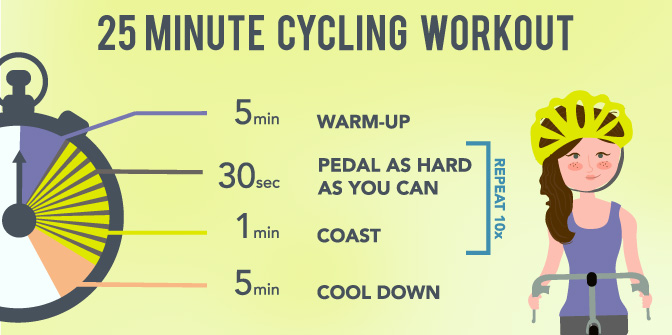
25-Minute Walking Workout
Warm-up for 5 minutes at a light pace. Walk for 30 seconds at a fast pace, and then walk
1 minute at a much slower resting pace. Repeat 10 times. Once you’ve mastered the
power-walking intervals, try incorporating 30-second jog intervals. Finish with a 5-
minute cool down.
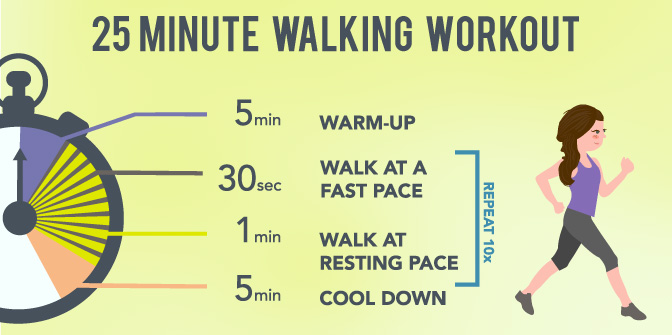
25-Minute Running Workout
Walk or jog for 5 minutes at a light pace to warm-up. Run for 30 seconds at maximum
effort, then jog or walk for 1 minute. Repeat 10 times. Finish with a 5-minute cool down.
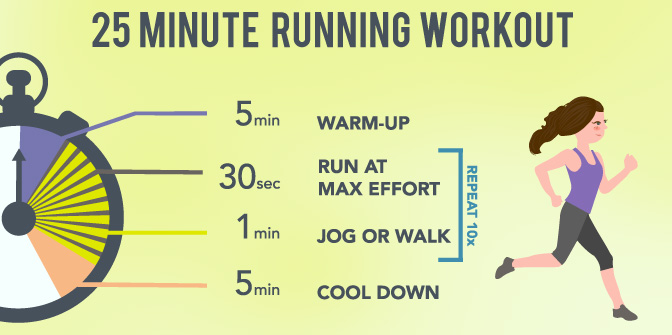
10-Minute Bodyweight Workout
Walk or jog for 2 minutes, or complete 1 minute of alternating bodyweight lunges and 1
minute of jumping jacks to warm-up. Rest for 30 seconds. Complete each of the
following exercises for 1-minute intervals with 30 seconds breaks in between.
- Squats
- Push-ups
- Scissor kicks
- Burpees
- Plank
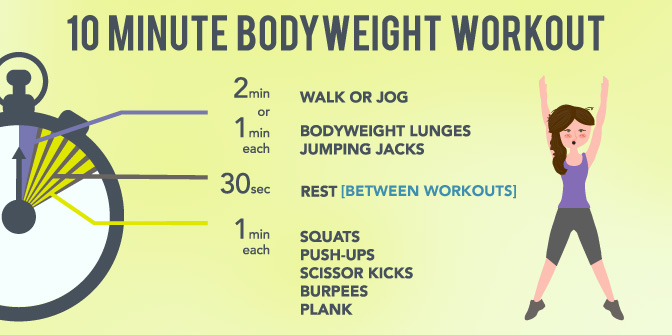
10-Minute Free Weight Workout
Walk or jog for 2 minutes, or complete 1 minute of alternating bodyweight lunges and 1
minute of jumping jacks to warm-up. Rest for 30 seconds. Complete each of the
following exercises for 1-minute intervals with 30 seconds breaks in between.
- Bicep Curls
- Shoulder Presses
- Squats
- Alternating lunges with weight overhead
- Russian Twists
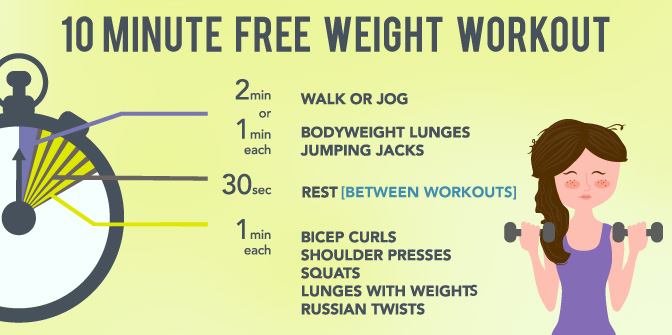
While Intervals allow us to increase training intensity without overtraining, high intensity
interval training isn’t appropriate for everyone. If you do not exercise on a regular basis
or have a chronic health condition, consult your doctor before trying an interval training
routine.
Embed the article on your site

